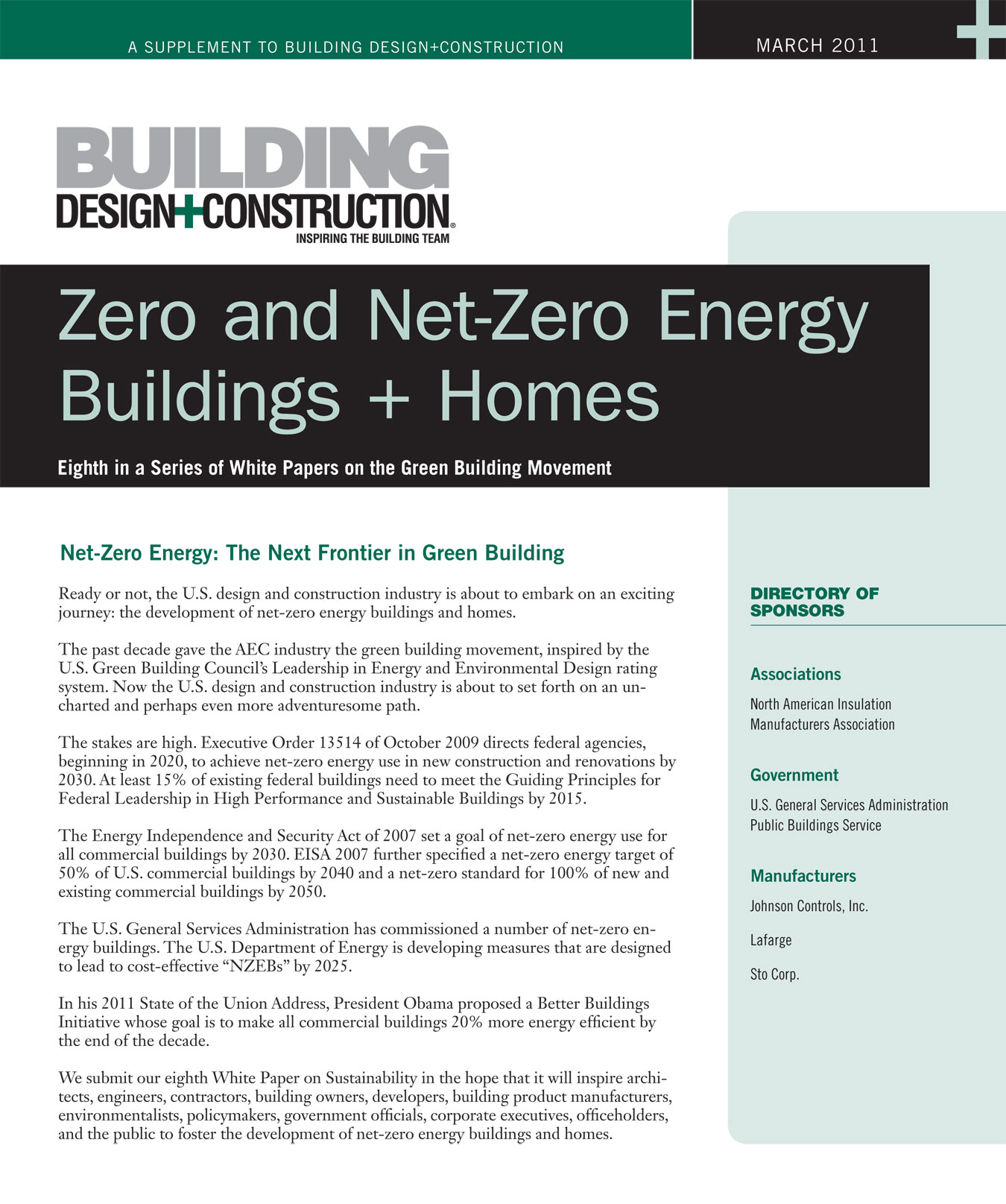“Zero and Net-zero Energy Buildings + Homes,” a 64-page White Paper that proclaims “the next frontier in the green building movement,” will be the topic of a 1-hr Q&A with 6 “NZEB” experts at the AIA Conference + Expo, Friday, May 13, 11 a.m. to 12 noon, at the Morial Convention Center (Level 2, Room R06), New Orleans.
The 40,000-word report from Building Design+Construction provides a road map for the $350 billion design, construction, and real estate industry to develop “net-zero” buildings and homes that generate as much energy as they use, such as the new Research Support Facility at the National Renewable Energy Laboratory, in Golden, Colo.
Robert Cassidy, BD+C’s editorial director, will moderate the discussion with the panel:
- Paul Torcellini, PE, PhD – U.S. Dept of Energy and National Renewable Energy Lab
- Tom Hootman, AIA, LEED AP – RNL Design (Research Support Facility design team)
- Philip Macey, AIA, LEED AP – Haselden Construction (Research Support Facility construction manager)
- Marc L’Italien, FAIA, LEED AP – EHDD Architecture (Exploratorium, Packard Foundation, and several other net-zero energy projects)
- Mary Ann Lazarus, FAIA, LEED AP – HOK (net-zero carbon prototype)
- David Eijadi, FAIA, LEED AP BD+C – The Weidt Group (environmental building consultant for Science House/Science Museum of Minn., net-zero carbon prototype)
Potential topics of discussion (questions from media representatives are welcome!):
- What did the experts learn from their NZEB experiences? What advice do they have for future NZEB designers, contractors, and building owners/developers?
- How do you measure and monitor the actual performance of NZEBs?
- What’s the “business case” for NZEBs? Do they make financial sense for owners?
- Is there a gulf between what the energy model predicts and actual outcome?
- What are the impediments – technical and otherwise – to producing NZEBs?
- What about net-zero energy (and net-zero carbon) for existing buildings?
The White Paper, along with seven previous reports devoted to green building, is available for free download at www.BDCnetwork.com/whitepapers.
The report was sponsored by Johnson Controls, Lafarge, North American Insulation Manufacturers Association, Sto Corp., and the U.S. General Services Administration.
Contact: Robert Cassidy, BD+C Editorial Director, rcassidy@sgcmail.com, 847-391-1040 office; 773-220-3555 mobile – Booth 142 at AIA
Related Stories
| Nov 29, 2010
Renovating for Sustainability
Motivated by the prospect of increased property values, reduced utility bills, and an interest in jumping on the sustainability bandwagon, a noted upturn in green building upgrades is helping designers and real estate developers stay busy while waiting for the economy to recover. In fact, many of the larger property management outfits have set up teams to undertake projects seeking LEED for Existing Buildings: Operations & Maintenance (LEED-EBOM, also referred to as LEED-EB), a certification by the U.S. Green Building Council.
| Nov 23, 2010
The George W. Bush Presidential Center, which will house the former president’s library
The George W. Bush Presidential Center, which will house the former president’s library and museum, plus the Bush Institute, is aiming for LEED Platinum. The 226,565-sf center, located at Southern Methodist University, in Dallas, was designed by architect Robert A.M. Stern and landscape architect Michael Van Valkenburgh.
| Nov 16, 2010
Brazil Olympics spurring green construction
Brazil's green building industry will expand in the coming years, spurred by construction of low-impact venues being built for the 2016 Olympics. The International Olympic Committee requires arenas built for the 2016 games in Rio de Janeiro meet international standards for low-carbon emissions and energy efficiency. This has boosted local interest in developing real estate with lower environmental impact than existing buildings. The timing couldn’t be better: the Brazilian government is just beginning its long-term infrastructure expansion program.
| Nov 16, 2010
Green building market grows 50% in two years; Green Outlook 2011 report
The U.S. green building market is up 50% from 2008 to 2010—from $42 billion to $55 billion-$71 billion, according to McGraw-Hill Construction's Green Outlook 2011: Green Trends Driving Growth report. Today, a third of all new nonresidential construction is green; in five years, nonresidential green building activity is expected to triple, representing $120 billion to $145 billion in new construction.
| Nov 16, 2010
Calculating office building performance? Yep, there’s an app for that
123 Zero build is a free tool for calculating the performance of a market-ready carbon-neutral office building design. The app estimates the discounted payback for constructing a zero emissions office building in any U.S. location, including the investment needed for photovoltaics to offset annual carbon emissions, payback calculations, estimated first costs for a highly energy efficient building, photovoltaic costs, discount rates, and user-specified fuel escalation rates.
| Nov 11, 2010
USGBC certifies more than 1 billion square feet of commercial space
This month, the total footprint of commercial projects certified under the U.S. Green Building Council’s LEED Green Building Rating System surpassed one billion square feet. Another six billion square feet of projects are registered and currently working toward LEED certification around the world. Since 2000, more than 36,000 commercial projects and 38,000 single-family homes have participated in LEED.
| Nov 9, 2010
Just how green is that college campus?
The College Sustainability Report Card 2011 evaluated colleges and universities in the U.S. and Canada with the 300 largest endowments—plus 22 others that asked to be included in the GreenReportCard.org study—on nine categories, including climate change, energy use, green building, and investment priorities. More than half (56%) earned a B or better, but 6% got a D. Can you guess which is the greenest of these: UC San Diego, Dickinson College, University of Calgary, and Dartmouth? Hint: The Red Devil has turned green.
| Nov 9, 2010
U.S. Army steps up requirements for greening building
Cool roofs, solar water heating, and advanced metering are among energy-efficiency elements that will have to be used in new permanent Army buildings in the U.S. and abroad starting in FY 2013. Designs for new construction and major renovations will incorporate sustainable design and development principles contained in ASHRAE 189.1.









